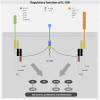Regulatory Role of IL-1R8 in Immunity and Disease
- PMID: 27148268
- PMCID: PMC4837151
- DOI: 10.3389/fimmu.2016.00149
Regulatory Role of IL-1R8 in Immunity and Disease
Abstract
Interleukin-1 receptor family members (ILRs) and toll-like receptors (TLRs) are characterized by the presence of a conserved intracellular domain and the toll-IL-1resistance (TIR) domain and are key players in immunity and inflammation. ILR and TLR signaling is tightly regulated at different levels. All cell types of the innate immune system express ILRs and TLRs. In addition, IL-1 family members are emerging as key players in the differentiation and function of innate and adaptive lymphoid cells. IL-1R8, also known as TIR8 or SIGIRR, is a fringe member of the ILR family and acts as a negative regulator of ILR and TLR signaling, which dampens ILR- and TLR-mediated cell activation. IL-1R8 is a component of the receptor recognizing human IL-37. Here, we summarize our current understanding of the structure and function of IL-1R8, focusing on its role in different pathological conditions, ranging from infectious and sterile inflammation to autoimmunity and cancer-related inflammation.
Keywords: cytokine; infection; inflammation; inflammation-associated cancer; interleukin-1; toll-like receptors.
Figures




References
Publication types
LinkOut - more resources
Full Text Sources
Other Literature Sources

